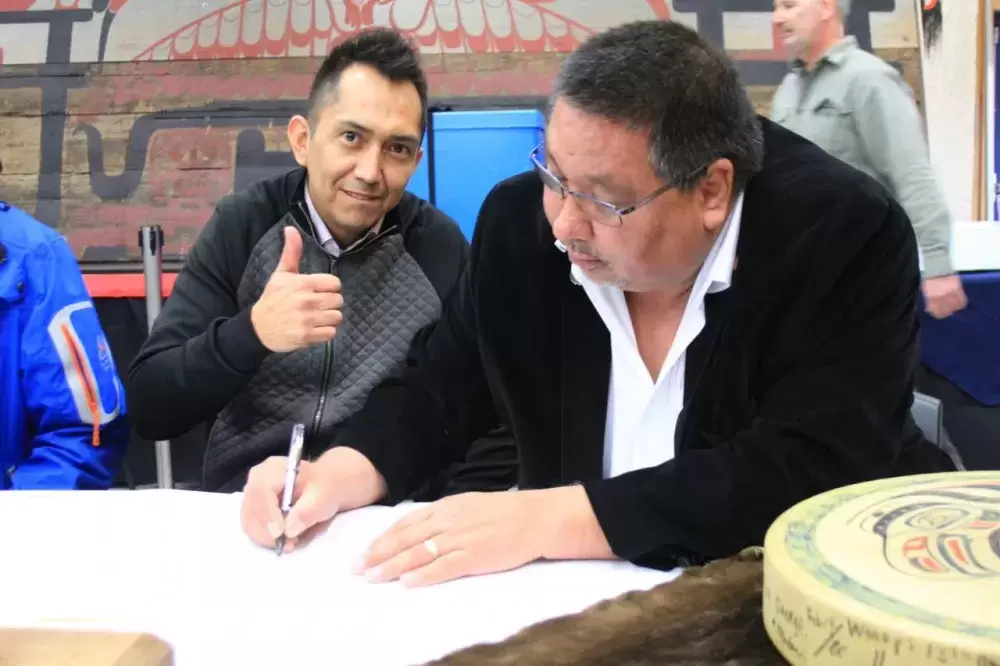Huu-ay-aht treasures are one step closer to being home. They arrived in Port Alberni today in early afternoon to be revealed at the Huu-ay-aht People’s Assembly this weekend.
Ownership of the 17 items was legally transferred from the Royal BC Museum to the Huu-ay-aht Ha’wiih (hereditary chiefs) with the formal signing of papers. A Huu-ay-aht ceremonial signing will occur tomorrow with their citizens to witness before the items go home to Anacla near Bamfield.
“This is a really awesome day,” said Tyee Ha’wilth Tliishin Derek Peters while standing in front of his family’s newly returned painted screen. It has been in the museum’s collection since 1911.
See our photos here: http://www.hashilthsa.com/gallery/huu-ay-aht-treasure-returned-nov-18-2016
Pointing to the screen, Tliishin said “If you think back to those times when we weren’t treated well for being who we are… actions and energies that were imposed into our nation, into our cultures and our identity in a way of trying to strip us from this…This is a symbol of pride and strength because we never went away from our teachings…hishukish tsawalk (we are all connected), iisaak (respect) and uu-a-thluk (taking care of).”
He said his entire nation upholds those principles.
Tliishin thanked all those who had a hand in bringing these items back into Huu-ay-aht possession, and reminded people that the journey home was the work of the ancestors as well, who did that work during a time when it was much harder to be Huu-ay-aht.
Wišqii Robert Dennis Jr., Tliishin’s speaker, said the repatriation was also due, in part, to the negotiation of the Maa-nulth Treaty.
“These treasures are going to be making their way home for the first time in more than 100 years,” said Wišqii. It’s very historic and a true demonstration of reconciliation, and our relationships.”
He said this was the result of years and years, and generations, of people working towards it… “a symbol of our treaty… that we would get all of our treasures back.”
It’s a “very historic moment and we will not forget this,” Wisqii said.
Martha Black, the Curator of Ethnology with the Royal BC Museum, had been working on the return of the treasures from the beginning, as part of the Maa-nulth Treaty while it was under negotiation.
From the treaty point of view, she said, the museum and Huu-ay-aht would share the collection; half of the collection is kept at the museum and the other half goes to the First Nation. Two equal lists, she said. And when the Huu-ay-aht requested their half, the museum sent it.
It was left entirely up to the Ha’wiih as to which items were returned.
“It is their treasure, so they were the ones that participated in the (treasure) that came back,” said Chief Councillor ʔimčis Robert Dennis Sr.
Asked what the museum had really wanted to keep in its half of the collection, Black said “We don’t really think that way. We’ve inherited this collection. The board (screen) was collected in 1911. The John Moses whaling material came in 1949. And some of the baskets in 1915 or so.
“The museum doesn’t think that we actually own it. Legally we own it, which was the reason for this transfer here… we are very aware that the first nations have the cultural ownership of it, so we are very happy to facilitate it.”
Black said the treasures have more resonance when they are home.
“It’s nice where the museum is, because people come from all over the world to see it and learn, we hope, and learn to respect first nations cultures…
“For myself, when working with this, we see it as active objects, or objects of agency… they do things. They aren’t just passive. They’re teaching. They are carrying the culture. They carry a lot of emotion. And so they move around and do things. They don’t just sit in the museum…”
Chief Councillor Dennis Sr. said it was a sense high excitement to see the treasures come through the doors, to “have your history come back to you, and the ancient spirit. You feel it. It’s something that you can’t describe. It’s a feeling.”
And he’s excited about the buzz that will be generated with the people tomorrow.
“It’s just huge... To witness our Ha’wiih signing the papers and having the (treasures) come back. You’re witnessing stuff that was banned, because of the Potlatch Act, and so to have them come back and for us to say this is ours… We are going to do what we want with our culture and our language, with the customs and traditions that we have… We are going to be Huu-ay-aht on our own terms. So that in itself is exciting.”
He was particularly glad to see the wooden screen come back because it was taken from the Huu-ay-ahts' main village.
“It was really good to see that one, because people, when they took that one, they knew that it represented a major part of Huu-ay-aht history.”
ʔimčis promised a big celebration tomorrow with many people dancing “because it’s us… we are returning. For me I can’t describe it. It’s more a feeling of excitement, happiness.”
See our video of Nov. 19 ceremony with the Huu-ay-aht citizens: https://youtu.be/nJgbFhxgOqA







